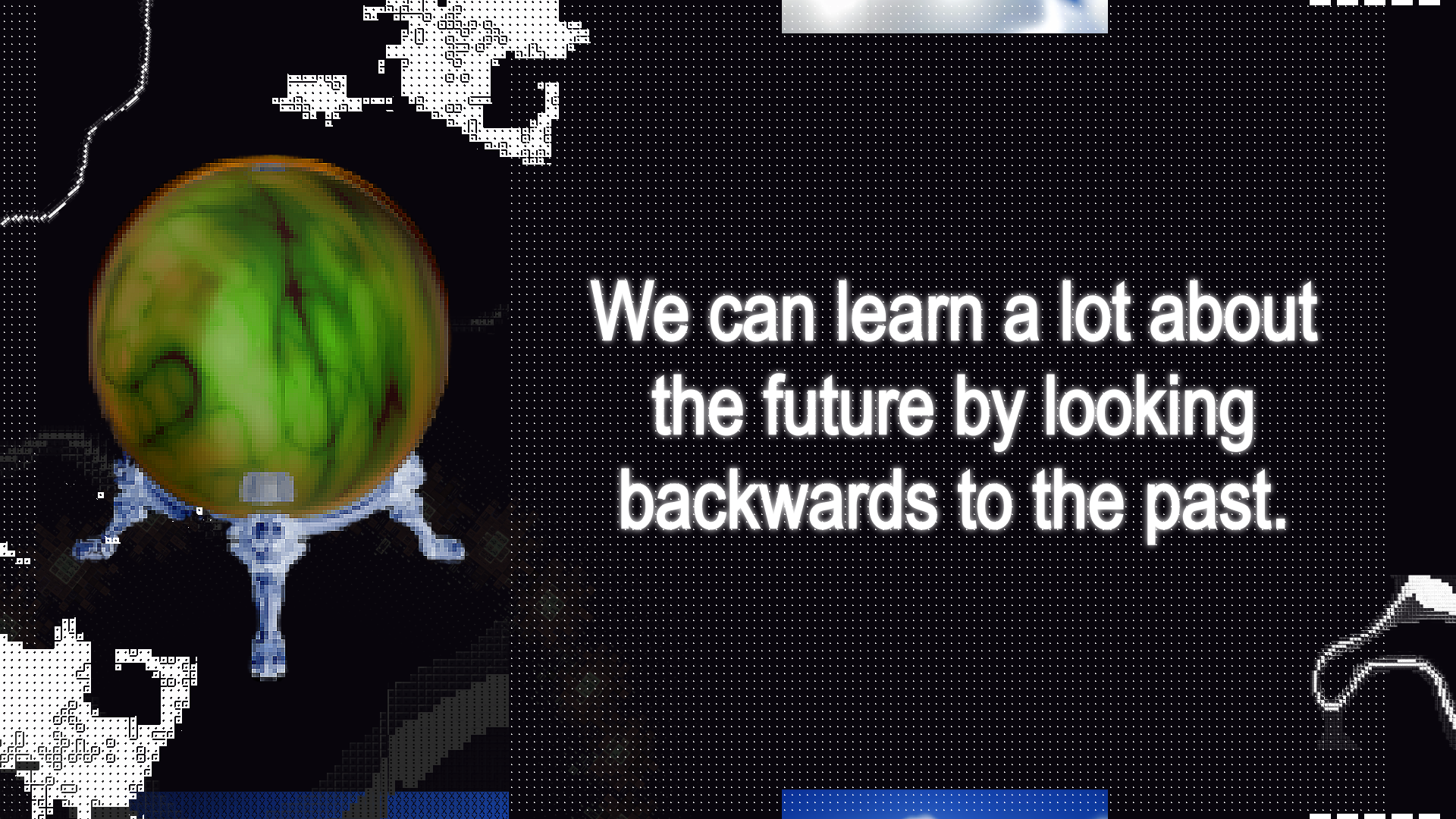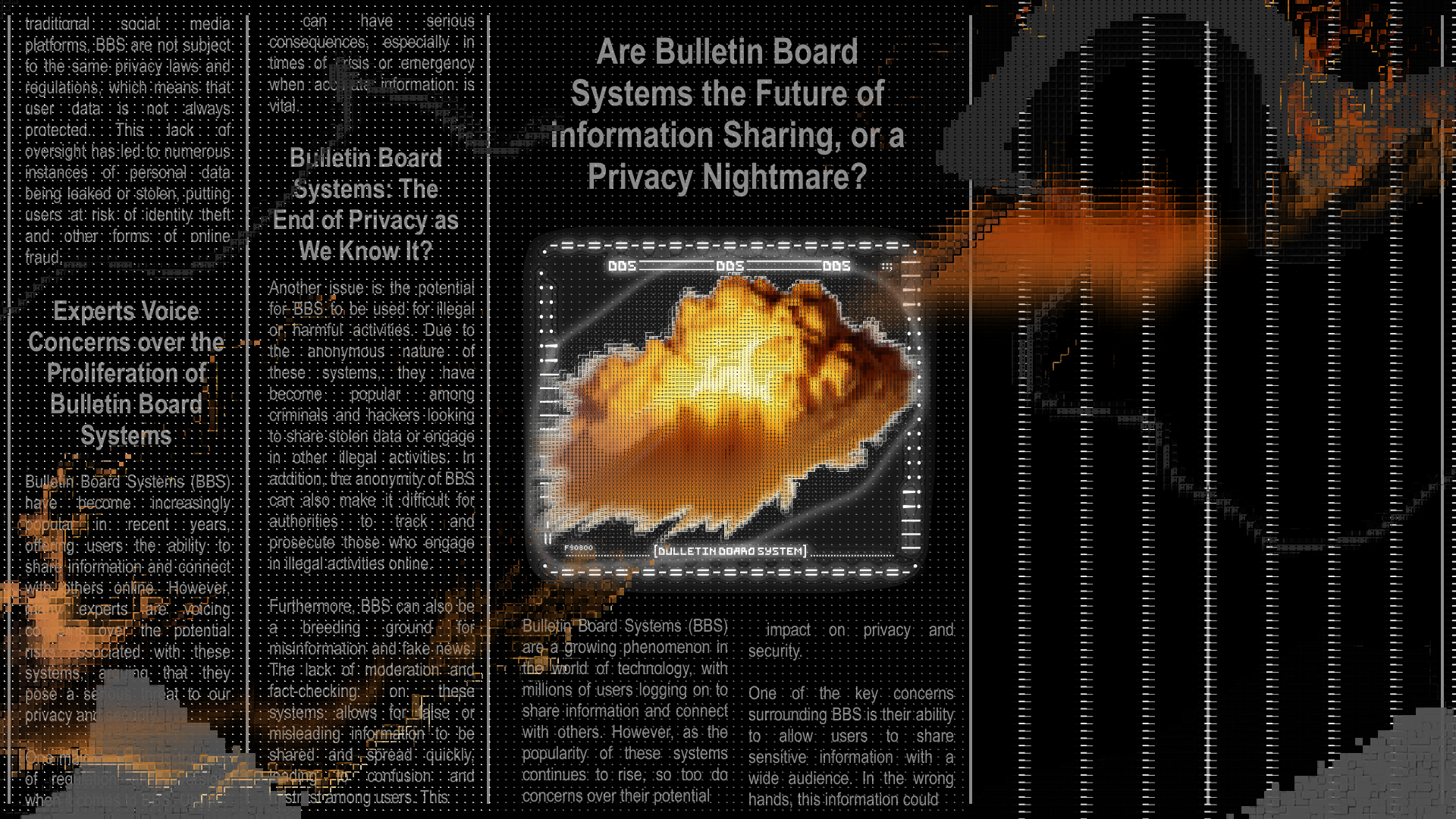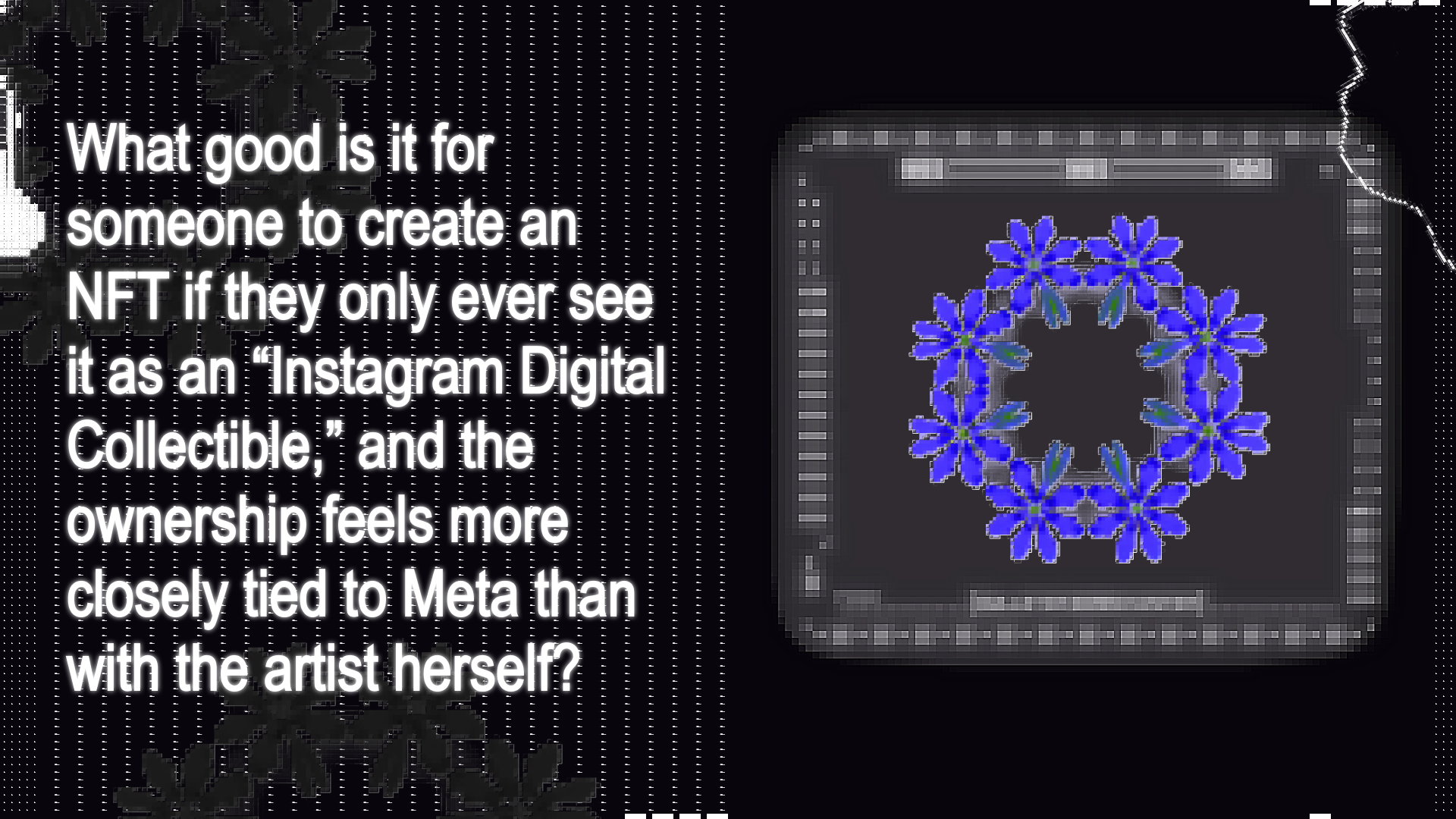- Ariel LeBeau
- Austin Robey
- David Blumenstein
- David Ehrlichman
- David Kerr
- Devon Moore
- Dexter Tortoriello
- Drew Coffman
- Drew Millard
- Eileen Isagon Skyers
- FWB Staff
- Greg Bresnitz
- Greta Rainbow
- Ian Rogers
- Jessica Klein
- Jose Mejia
- Kelani Nichole
- Kelsie Nabben
- Kevin Munger
- Khalila Douze
- Kinjal Shah
- LUKSO
- Lindsay Howard
- Maelstrom
- Marc Moglen
- Marvin Lin
- Mary Carreon
- Matt Newberg
- Mike Pearl
- Mike Sunda (PUSH)
- Moyosore Briggs
- Nicole Froio
- Ruby Justice Thelot
- Simon Hudson
- Steph Alinsug
- The Blockchain Socialist
- Willa Köerner
- Yana Sosnovskaya
- Yancey Strickler
- iz

Wed Dec 07 2022

Web3 is at a clear inflection point: On the one hand, corporations like Meta, Starbucks, and Ticketmaster are co-opting its underlying technologies; on the other, a series of high-profile disasters has created a reputational dumpster fire hampering its momentum and perceived potential. It's less clear than ever whether web3 will be the future of the internet, or simply stripped for parts by centralized players hoping to wring some profit out of it.
This is a common cycle for new technologies: They are hyped as the imminent future, then rapidly adopted by many — only to be left behind as they fail to hold our collective attention and people move on in search of the next big thing. Sometimes a technology or product is good enough to escape this loop and becomes a fixture of our everyday lives (can you remember a world before Netflix?). Most of the time, though, these groundbreaking new inventions go the way of products like Google Glass and slowly disappear. Either way, we can learn a lot about the future by looking back on moments when new technologies felt poised to remake the world, then failed — especially when they remind us of where we find ourselves right now.
One of those moments was the rise of Bulletin Board Systems (BBSs), a constellation of early online communities dating back to the 1970s. From BBSs’ nature as open and decentralized networks where people could connect around shared interests, to their struggles with public perception and the pressures of internet consolidation, the story of this early iteration of the internet leaves behind clear lessons that are directly applicable to the present. Remembering them may be key to avoiding a scenario where web3 and its associated technologies become just another footnote in the history of the internet.
BBSs were text-based portals where users could play games, share files, and chat with other community members. Because they required participants to dial in using a modem and a landline, BBSs were mostly regional: communicating with people who lived outside your vicinity could require expensive, long-distance calls. This made them akin to geographically localized online neighborhoods, focused on things like regions (i.e. the Chicago-based CBBS), shared interests (i.e. Event Horizons BBS, a file-sharing hub for astrology images), or identity (i.e. the women-only Sapho BBS).
Kevin Driscoll’s book, Modem World, looks back at this era of internet prehistory as an early model of an open network, built by passionate futurists looking to connect with one another. At a time when computers were mostly considered workhorse devices for crunching numbers, Driscoll argues, “the hobbyist groups that built dial-up BBSs in the 1970s transformed the idea of the computer network from a tool of work into a space for communication, culture, and play.” Society’s most lasting cultural memory of BBSs is probably John Badham’s 1984 film War Games, where a young BBS user played by Matthew Broderick prevents World War III by making a super-computer play Tic Tac Toe. But at their height in the mid-90s, according to recent estimates, the BBS community had grown from a small handful of hobbyists to 2.5 million people.
The decentralized ethos of BBSs will likely sound familiar to anyone exploring web3. The BBS system emphasized community, allowed for user privacy, and enabled people to convene around the things they cared about. Now, that culture of privacy, community, and autonomy is alive once more — which, for many of us, feels great. However, if we want to build an internet that truly fosters these values, it’s instructive to look back at how BBSs were perceived, and ultimately replaced.

ON PERCEPTION
One of the most obvious parallels between the BBS scene and web3 is in the diversity of communities it gave rise to, and the often-unfortunate narratives to which that breadth lent itself. One popular bulletin board was The WELL, short for “Whole Earth ‘Lectronic Link,” an offshoot of the Whole Earth Catalog that began as an online gathering space for people who were passionate about self-sufficient living, The Grateful Dead, and other interests that grew out of the Bay Area counterculture of the 1960s and ’70s. It was a community known for its thoughtful and respectful user base — one so healthy, it still exists to this day.
The focus on community and openness within BBSs, however, was a double-edged sword. Though the majority of users flocked to environments like The WELL, the decentralized nature of the technology meant that it could be used for both good and bad — with the latter, predictably, drawing the lion’s share of the mainstream press’s attention. Indeed, much of the coverage of BBSs in the ’80s focused on stories about neo-Nazi groups coordinating via BBS, or servers becoming home to illegal file-sharing of scanned magazines like Playboy.
These days, it’s like we’re watching history repeat itself. Though web3 tech has the potential to be used for radically powerful identity management and decentralized ownership mechanisms, the media’s coverage of the space has mostly focused on blatant ponzi schemes, Bored Apes, and Elon Musk talking about Dogecoin. But BBSs teach us that this is largely a perception issue: In Modem World, Driscoll explores how the BBS community lacked strong representation in mainstream conversations about the future of the internet. The negative media narrative ultimately won out over the truth, which was that the majority of people who participated in BBSs were creating meaningful and positive community spaces. Faced with a choice between navigating clunky BBS servers and signing up for an email address and username using a major player like AOL — which, coincidentally, curtailed freedom of choice in favor of centralized services like AOL Instant Messenger and AOL chat rooms — most early internet users (understandably) opted for the latter.
Similarly, discussions about web3’s potential to be used for truly disruptive purposes get lost in a sea of articles about the space's biggest horror stories. To make matters worse, some of the loudest anti-web3 voices today aren’t simply uninformed; they’re intentionally and purposefully hostile.
Much of the skepticism towards web3 is warranted, especially when it comes to reports of alleged insider trading, half-baked NFT projects, CEXs going bankrupt, and blatant celebrity cash grabs. The fact that these stories are not only attracting the attention of the media, but also genuinely ingrained in the ecosystem as we know it today, is a real problem. But it’s notable that a lot of the backlash is coming from those who have major interests in allowing traditional institutions to maintain their dominance. Because of this negative perception, if people were forced to choose between our current web3 and web 2.0 tools today, they’d almost certainly stick with the ones they’re already familiar with.
This time around, the stakes are much higher than they were with BBSs. The internet is no longer just an interesting space for hobbyists; it's an entirely new economy, and a space that is completely enmeshed with our everyday lives — work, play, and everything in between. Decentralization has the potential to revolutionize our banking and financial systems, preserve our privacy, and enable a deeper level of online identity than was previously possible. Web3 tech offers the tools we need to build an internet that is more thoughtful and less exploitative, free from the ills of massive data collection and manipulation, surveillance capitalism, and platform monopolies. But that internet cannot possibly become a reality until more people get involved and begin to genuinely benefit from what’s being developed in real and meaningful ways.
Now that much of the smoke has cleared away, many of the speculators have exited, and the cash grabs have dwindled down, we have the opportunity to refocus on — and amplify — the positive use cases that we know exist within web3. We must advocate for our technology and our communities by telling compelling stories about these tools and the future that they make possible.

ON NAMES
While BBSs were losing ground to more accessible internet options like AOL and Prodigy, Driscoll notes that an interesting thing happened: “When a moral panic over ‘cyberporn’ threatened to burst the dot-com bubble in 1995, BBSs provided a convenient scapegoat,” he writes. “BBSs were old and dirty; the internet and the web were new, clean, and safe for commerce. Facing this stigma, many enterprising BBS operators quietly rebranded. Seemingly overnight, thousands of dial-up BBSs vanished, replaced by brand-new ‘internet service providers.’”
ISPs were entry points to the nascent web, granting anyone with a modem access to a growing collection of websites being created across the globe, as well as access to protocols like email. Many BBS operators had already started allowing users to access the internet alongside their bulletin boards. And so, over time, instead of continuing to fight against this form of competition, many BBSs simply opted to become more like ISPs. BBS operators revised their login pages and converted them into linked lists of popular websites, often changing their names to promote themselves as internet service providers instead of bulletin board systems. Over time, the term “BBS” fell into obscurity.
It can be tempting to rebrand to escape a negative stigma, and I expect that we’ll see the web3 tech stack, as well as the space’s projects and communities, shift away from today’s terminologies in favor of, well… blending in with the rest of the internet. NFTs might evolve into “digital collectibles”; DAOs could become “decentralized communities,” and so on. On the one hand, this may be what web3 needs to do to ensure its short-term survival. People who know crypto will know that blockchain technology forms the basis of these tools, but for the rest of the world, its existence could simply be swept under the rug. On the other, there is a risk in rebranding web3 to look more user-friendly and safe: Resurfacing tools to keep the technology out of view may make them less polarizing, but they can also lead to fewer people being able to participate in the creation and curation of the new internet.
In the same way that the once-thriving BBS scene was gradually absorbed into a more centralized (and sanitized) web led by major corporations, web3 could become just another toolset enabling centralized web 2.0 players to continue their reign. What good is it for someone to create an NFT if they only ever see it as an “Instagram Digital Collectible,” and the ownership feels more closely tied to Meta than with the artist herself?
The best rebrands will stay true to the underlying principles and ideas of web3 while also providing a more user-friendly way in. Terms like “wallet,” which can evoke fears of loss and insecurity, could be replaced by terms that evoke a sense of connectivity and meaning — words that point to what you can do with a wallet rather than specifically focusing on what you own. However, a wallet’s nature as a place where people can store assets shouldn’t be obfuscated so much that people don’t understand the importance of owning their own “keys.” Finding the right way to communicate these concepts is extremely important, as small wording choices do make a difference.
Most importantly, we need to remember that we are not the first generation to dream of a more open and decentralized internet, and that there is a lot we can learn from the generations that came before us. “To imagine a better future for the internet,” Driscoll writes, “we need a more robust account of internet history, one that includes the abandoned prototypes and paths not taken of a more experimental era.”
BBSs were popularized by individuals and small groups who built and operated their own systems, and who were motivated by a desire to connect with others and share what they loved. The fact that they existed at all is a reminder that it’s possible to build an internet that is more democratic, equitable, and inclusive — a digital world made up of a multitude of independent communities, each with its own thriving culture. But it’s also a reminder that this world we’ve created could almost entirely disappear, subsumed by another version of today's centralized, corporately controlled internet.
BBSs lost the war of web 1.0 because they were unable to gain mass cultural relevance. Ultimately, they were supplanted by major corporations with large amounts of funding, companies that were able to grow so rapidly that they quickly became unstoppable. The good news is that being “the biggest” is no longer a requirement. We live in a world where communities like FWB can survive and actually thrive in a way that BBSs were never able to, by tokenizing membership and creating meaningful paths for revenue that weren’t available to hobbyist BBS operators dialing in on a landline. The era of BBSs is proof that small, self-run communities can flourish in the digital world. Now we have the tools to build online neighborhoods that stand the test of time.
Drew Coffman is a web3 optimist with a deep nostalgia for the tech of the ’90s and 2000s. He spends his time contributing to FWB as a community manager and chilling in #nft-general-chat. He wrote this essay with some early assistance from the AI writing tool Lex to cut through writer’s block. It was refined across multiple drafts, and edited by three humans.
Images by Carlos Sanchez. Newspaper elements generated by ChatGPT.


